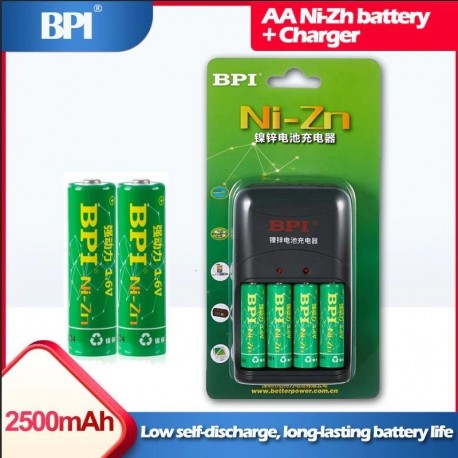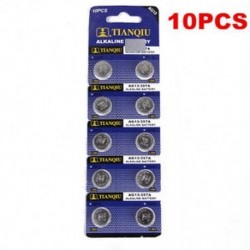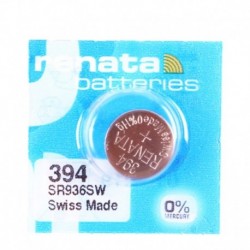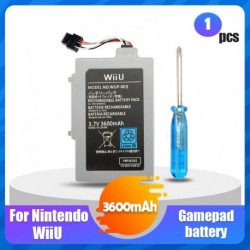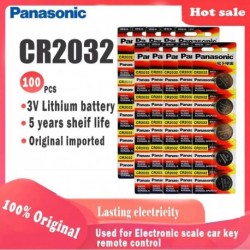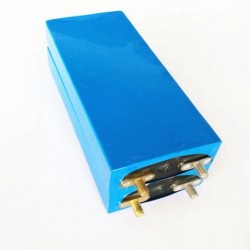Kosár
0
Termék
Termék
(üres)
Nincs termék
To be determined
Szállítás
0 Ft
Összesen
Termék a kosaradba helyezve
Mennyiség
Összesen
0 termék a kosaradban.
1 termék a kosaradban.
Termék összesen
Szállítás összesen
To be determined
Összesen
4db Ni-Zn 1.6V AA 2500mWh mAh újratölthető akkumulátor BPI NiZn intelligens töltő, sokkal erősebb és erősebb, mint a
32809097302
Új termék
4PCS BPI Ni-Zn 1.6V AA 2500mWh mAh Rechargeable Battery BPI NiZn smart Charger Much Powerful and stronger PK Ni-MH battery
Features:
Brand new and high quality
No memory effect.
Hybrid of power stable.
Voltage: 1.6V.
Chemistry: Ni-Zn
Capacity: 2500mWh.
Rechargeable times: up to 1000 times.
Can be rapidly charged with any quick charger, smart chargers, plug in charger or universal chargers.
Excellent performance in digital cameras, CD players, remote control vehicles, metal detectors, pocket flashlights, PDAs palm pilots, pagers, game boys, children's toys, etc.
Charger:
INPUTE : AC 100-240V, 50/60Hz International Compatible
OUTPUT:DC 4 x (1.6v --350mA) AA/ 2 x AAA Size
NiZn Fast Charger :
Main Features:
Charges 1-4 AA/1-2 AAA Ni-Zn Batteries
Reverse Polarity Protection
CC-CV control
4 LED indicate battery charging status
Low Battery Leakage Current
Low Voltage Restore Feature
LED Indicator: Easy to Monitor LED Charge Indicators
Red LED ON: Charging in progress
Red LED OFF:Charging complete
Pictures:
Question1: Is 1.6V safe? If the electrical appliance requires 1.5V, will 1.6V cause damage?
Q&A: In fact, all electrical appliances have a certain margin for the working voltage, which can be adapted to a slightly higher or slightly lower voltage (usually about 20% fluctuations) and can be used normally, but four or more are not recommended Multiple nickel-zinc batteries are used in series, because the cumulative voltage increase is large, users with certain experience can try it.
Question2: 2500 is printed on the battery package and 1500 is written in the actual description. Is it a false standard?
Answer: At present, nickel-zinc batteries are marked in milliwatt-hour units, that is, the power that can be output under 1.6V working voltage, instead of the milliamp-hour unit marked by traditional 1.2V rechargeable batteries. The two do not conflict and are not allowed. For comparison only by figures, under the premise of the same volume (for example, all battery specifications are No. 5), the higher the output voltage, the lower the actual current (milliamp-hour), but the output power (milliwatt-hour) Almost, this is because the energy density ratio of the chemical materials used in the No. 5 battery has reached a bottleneck. It is obviously impossible to use new materials with higher energy density to break through.
Question3: Are nickel-zinc batteries easy to break? Why can't I over-discharge and over-charge?
Answer: Overdischarge and overcharge are harmful to any rechargeable battery. In the past, the 1.2V rechargeable battery has a low voltage and cannot drive the electrical appliances before the battery is used up. Such frequent charging, such as 1.2 V nickel-cadmium batteries will have memory, which makes the charging and use effect worse and worse, so there is a popular saying that rechargeable batteries must be used up and recharged, and even deliberately discharge the light to recharge. Many users are influenced by this concept, and they charge other rechargeable batteries deeply. They don’t know the current changes in battery chemistry. Except for the 1.2V rechargeable battery, the rechargeable batteries of other materials have no memory. Over-discharge causes the internal production of crystals in the battery to pierce the diaphragm and cause an internal short-circuit in the battery; over-charge is more harmful, a large amount of gas is generated inside the battery, and the air pressure is too high, which may cause bulging or even explosion. However, as long as the matching smart charger is used, the risk of overcharging is basically non-existent.
Question4: Now that 1.5V lithium batteries have appeared, is it still necessary to buy 1.6V nickel-zinc batteries?
Q&A: The emergence of 1.5V lithium batteries has indeed solved many users’ difficulty in choosing. There is no 1.5V output rechargeable lithium battery in the world. A 1.5V lithium battery like Juji is actually more like a power bank. In fact, it is still a standard 3.7V lithium battery, but the power bank boosts 3.7V to 5V to charge mobile phones and other digital products, while Juji steps down the 3.7V lithium battery to 1.5V output, which is true in terms of voltage. It is more stable. However, due to the limitation of the step-down circuit, the output current cannot exceed 2A, and there will be interference and noise when used in the radio and wireless microphones. In this regard, the output of the 1.6V nickel-zinc battery is not limited, and it will not If there is interference, it is still very advantageous to use in equipment that requires high power output or pure voltage and current.
-2
/
 2
/ Gyorsan Fogyó termék
2
/ Gyorsan Fogyó termék
Egyéb infó
4db Ni-Zn 1.6V AA 2500mWh mAh újratölthető akkumulátor BPI NiZn intelligens töltő, sokkal erősebb és erősebb, mint a Ni-MH akkumulátor
4pcs Ni-Zn 1.6V AA 2500mWh mAh Rechargeable Battery BPI NiZn smart Charger , Much Powerful and stronger than Ni-MH battery
4PCS BPI Ni-Zn 1.6V AA 2500mWh mAh Rechargeable Battery BPI NiZn smart Charger Much Powerful and stronger PK Ni-MH battery
Features:
Brand new and high quality
No memory effect.
Hybrid of power stable.
Voltage: 1.6V.
Chemistry: Ni-Zn
Capacity: 2500mWh.
Rechargeable times: up to 1000 times.
Can be rapidly charged with any quick charger, smart chargers, plug in charger or universal chargers.
Excellent performance in digital cameras, CD players, remote control vehicles, metal detectors, pocket flashlights, PDAs palm pilots, pagers, game boys, children's toys, etc.
Charger:
INPUTE : AC 100-240V, 50/60Hz International Compatible
OUTPUT:DC 4 x (1.6v --350mA) AA/ 2 x AAA Size
NiZn Fast Charger :
Main Features:
Charges 1-4 AA/1-2 AAA Ni-Zn Batteries
Reverse Polarity Protection
CC-CV control
4 LED indicate battery charging status
Low Battery Leakage Current
Low Voltage Restore Feature
LED Indicator: Easy to Monitor LED Charge Indicators
Red LED ON: Charging in progress
Red LED OFF:Charging complete
Pictures:
Question1: Is 1.6V safe? If the electrical appliance requires 1.5V, will 1.6V cause damage?
Q&A: In fact, all electrical appliances have a certain margin for the working voltage, which can be adapted to a slightly higher or slightly lower voltage (usually about 20% fluctuations) and can be used normally, but four or more are not recommended Multiple nickel-zinc batteries are used in series, because the cumulative voltage increase is large, users with certain experience can try it.
Question2: 2500 is printed on the battery package and 1500 is written in the actual description. Is it a false standard?
Answer: At present, nickel-zinc batteries are marked in milliwatt-hour units, that is, the power that can be output under 1.6V working voltage, instead of the milliamp-hour unit marked by traditional 1.2V rechargeable batteries. The two do not conflict and are not allowed. For comparison only by figures, under the premise of the same volume (for example, all battery specifications are No. 5), the higher the output voltage, the lower the actual current (milliamp-hour), but the output power (milliwatt-hour) Almost, this is because the energy density ratio of the chemical materials used in the No. 5 battery has reached a bottleneck. It is obviously impossible to use new materials with higher energy density to break through.
Question3: Are nickel-zinc batteries easy to break? Why can't I over-discharge and over-charge?
Answer: Overdischarge and overcharge are harmful to any rechargeable battery. In the past, the 1.2V rechargeable battery has a low voltage and cannot drive the electrical appliances before the battery is used up. Such frequent charging, such as 1.2 V nickel-cadmium batteries will have memory, which makes the charging and use effect worse and worse, so there is a popular saying that rechargeable batteries must be used up and recharged, and even deliberately discharge the light to recharge. Many users are influenced by this concept, and they charge other rechargeable batteries deeply. They don’t know the current changes in battery chemistry. Except for the 1.2V rechargeable battery, the rechargeable batteries of other materials have no memory. Over-discharge causes the internal production of crystals in the battery to pierce the diaphragm and cause an internal short-circuit in the battery; over-charge is more harmful, a large amount of gas is generated inside the battery, and the air pressure is too high, which may cause bulging or even explosion. However, as long as the matching smart charger is used, the risk of overcharging is basically non-existent.
Question4: Now that 1.5V lithium batteries have appeared, is it still necessary to buy 1.6V nickel-zinc batteries?
Q&A: The emergence of 1.5V lithium batteries has indeed solved many users’ difficulty in choosing. There is no 1.5V output rechargeable lithium battery in the world. A 1.5V lithium battery like Juji is actually more like a power bank. In fact, it is still a standard 3.7V lithium battery, but the power bank boosts 3.7V to 5V to charge mobile phones and other digital products, while Juji steps down the 3.7V lithium battery to 1.5V output, which is true in terms of voltage. It is more stable. However, due to the limitation of the step-down circuit, the output current cannot exceed 2A, and there will be interference and noise when used in the radio and wireless microphones. In this regard, the output of the 1.6V nickel-zinc battery is not limited, and it will not If there is interference, it is still very advantageous to use in equipment that requires high power output or pure voltage and current.
32809097302 - zhisheng
4pcs Ni-Zn 1.6V AA 2500mWh mAh Rechargeable Battery BPI NiZn smart Charger , Much Powerful and stronger than Ni-MH battery
4PCS BPI Ni-Zn 1.6V AA 2500mWh mAh Rechargeable Battery BPI NiZn smart Charger Much Powerful and stronger PK Ni-MH battery
Features:
Brand new and high quality
No memory effect.
Hybrid of power stable.
Voltage: 1.6V.
Chemistry: Ni-Zn
Capacity: 2500mWh.
Rechargeable times: up to 1000 times.
Can be rapidly charged with any quick charger, smart chargers, plug in charger or universal chargers.
Excellent performance in digital cameras, CD players, remote control vehicles, metal detectors, pocket flashlights, PDAs palm pilots, pagers, game boys, children's toys, etc.
Charger:
INPUTE : AC 100-240V, 50/60Hz International Compatible
OUTPUT:DC 4 x (1.6v --350mA) AA/ 2 x AAA Size
NiZn Fast Charger :
Main Features:
Charges 1-4 AA/1-2 AAA Ni-Zn Batteries
Reverse Polarity Protection
CC-CV control
4 LED indicate battery charging status
Low Battery Leakage Current
Low Voltage Restore Feature
LED Indicator: Easy to Monitor LED Charge Indicators
Red LED ON: Charging in progress
Red LED OFF:Charging complete
Pictures:
Question1: Is 1.6V safe? If the electrical appliance requires 1.5V, will 1.6V cause damage?
Q&A: In fact, all electrical appliances have a certain margin for the working voltage, which can be adapted to a slightly higher or slightly lower voltage (usually about 20% fluctuations) and can be used normally, but four or more are not recommended Multiple nickel-zinc batteries are used in series, because the cumulative voltage increase is large, users with certain experience can try it.
Question2: 2500 is printed on the battery package and 1500 is written in the actual description. Is it a false standard?
Answer: At present, nickel-zinc batteries are marked in milliwatt-hour units, that is, the power that can be output under 1.6V working voltage, instead of the milliamp-hour unit marked by traditional 1.2V rechargeable batteries. The two do not conflict and are not allowed. For comparison only by figures, under the premise of the same volume (for example, all battery specifications are No. 5), the higher the output voltage, the lower the actual current (milliamp-hour), but the output power (milliwatt-hour) Almost, this is because the energy density ratio of the chemical materials used in the No. 5 battery has reached a bottleneck. It is obviously impossible to use new materials with higher energy density to break through.
Question3: Are nickel-zinc batteries easy to break? Why can't I over-discharge and over-charge?
Answer: Overdischarge and overcharge are harmful to any rechargeable battery. In the past, the 1.2V rechargeable battery has a low voltage and cannot drive the electrical appliances before the battery is used up. Such frequent charging, such as 1.2 V nickel-cadmium batteries will have memory, which makes the charging and use effect worse and worse, so there is a popular saying that rechargeable batteries must be used up and recharged, and even deliberately discharge the light to recharge. Many users are influenced by this concept, and they charge other rechargeable batteries deeply. They don’t know the current changes in battery chemistry. Except for the 1.2V rechargeable battery, the rechargeable batteries of other materials have no memory. Over-discharge causes the internal production of crystals in the battery to pierce the diaphragm and cause an internal short-circuit in the battery; over-charge is more harmful, a large amount of gas is generated inside the battery, and the air pressure is too high, which may cause bulging or even explosion. However, as long as the matching smart charger is used, the risk of overcharging is basically non-existent.
Question4: Now that 1.5V lithium batteries have appeared, is it still necessary to buy 1.6V nickel-zinc batteries?
Q&A: The emergence of 1.5V lithium batteries has indeed solved many users’ difficulty in choosing. There is no 1.5V output rechargeable lithium battery in the world. A 1.5V lithium battery like Juji is actually more like a power bank. In fact, it is still a standard 3.7V lithium battery, but the power bank boosts 3.7V to 5V to charge mobile phones and other digital products, while Juji steps down the 3.7V lithium battery to 1.5V output, which is true in terms of voltage. It is more stable. However, due to the limitation of the step-down circuit, the output current cannot exceed 2A, and there will be interference and noise when used in the radio and wireless microphones. In this regard, the output of the 1.6V nickel-zinc battery is not limited, and it will not If there is interference, it is still very advantageous to use in equipment that requires high power output or pure voltage and current.
32809097302 - zhisheng

